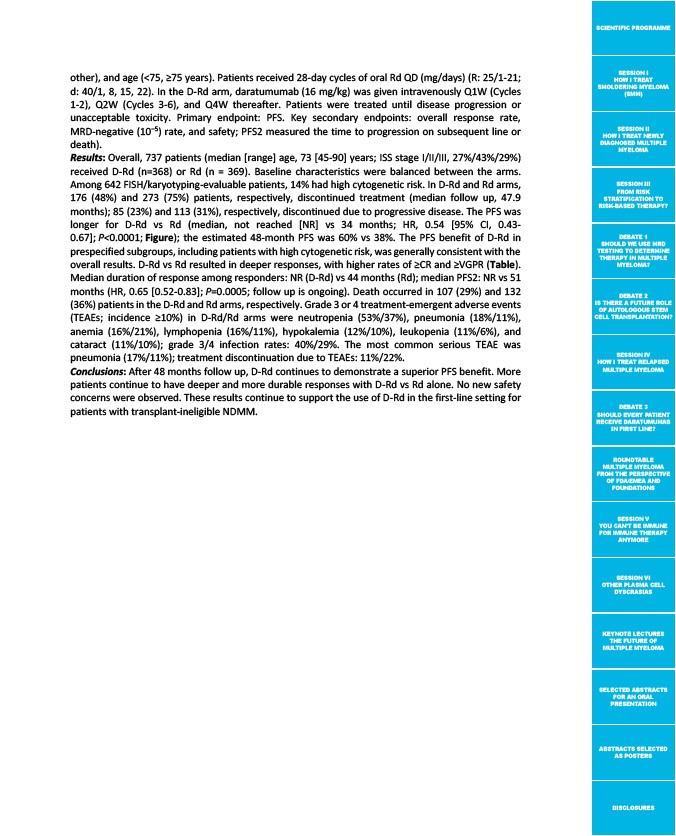
SCIENTIFIC PROGRAMME
SESSION I
HOW I TREAT
SMOLDERING MYELOMA
(SMM)
SESSION II
HOW I TREAT NEWLY
DIAGNOSED MULTIPLE
MYELOMA
SESSION III
FROM RISK
STRATIFICATION TO
RISK-BASED THERAPY?
DEBATE 1
SHOULD WE USE MRD
TESTING TO DETERMINE
THERAPY IN MULTIPLE
MYELOMA?
DEBATE 2
IS THERE A FUTURE ROLE
OF AUTOLOGOUS STEM
CELL TRANSPLANTATION?
SESSION IV
HOW I TREAT RELAPSED
MULTIPLE MYELOMA
DEBATE 3
SHOULD EVERY PATIENT
RECEIVE DARATUMUMAB
IN FIRST LINE?
ROUNDTABLE
MULTIPLE MYELOMA
FROM THE PERSPECTIVE
OF FDA/EMEA AND
FOUNDATIONS
SESSION V
YOU CAN’T BE IMMUNE
FOR IMMUNE THERAPY
ANYMORE
SESSION VI
OTHER PLASMA CELL
DYSCRASIAS
KEYNOTE LECTURES
THE FUTURE OF
MULTIPLE MYELOMA
SELECTED ABSTRACTS
FOR AN ORAL
PRESENTATION
ABSTRACTS SELECTED
AS POSTERS
DISCLOSURES
other), and age (<75, ≥75 years). Patients received 28-day cycles of oral Rd QD (mg/days) (R: 25/1-21;
d: 40/1, 8, 15, 22). In the D-Rd arm, daratumumab (16 mg/kg) was given intravenously Q1W (Cycles
1-2), Q2W (Cycles 3-6), and Q4W thereafter. Patients were treated until disease progression or
unacceptable toxicity. Primary endpoint: PFS. Key secondary endpoints: overall response rate,
MRD-negative (10−5) rate, and safety; PFS2 measured the time to progression on subsequent line or
death).
Results: Overall, 737 patients (median range age, 73 45-90 years; ISS stage I/II/III, 27%/43%/29%)
received D-Rd (n=368) or Rd (n = 369). Baseline characteristics were balanced between the arms.
Among 642 FISH/karyotyping-evaluable patients, 14% had high cytogenetic risk. In D-Rd and Rd arms,
176 (48%) and 273 (75%) patients, respectively, discontinued treatment (median follow up, 47.9
months); 85 (23%) and 113 (31%), respectively, discontinued due to progressive disease. The PFS was
longer for D-Rd vs Rd (median, not reached NR vs 34 months; HR, 0.54 95% CI, 0.43-
0.67; P<0.0001; Figure); the estimated 48-month PFS was 60% vs 38%. The PFS benefit of D-Rd in
prespecified subgroups, including patients with high cytogenetic risk, was generally consistent with the
overall results. D-Rd vs Rd resulted in deeper responses, with higher rates of ≥CR and ≥VGPR (Table).
Median duration of response among responders: NR (D-Rd) vs 44 months (Rd); median PFS2: NR vs 51
months (HR, 0.65 0.52-0.83; P=0.0005; follow up is ongoing). Death occurred in 107 (29%) and 132
(36%) patients in the D-Rd and Rd arms, respectively. Grade 3 or 4 treatment-emergent adverse events
(TEAEs; incidence ≥10%) in D-Rd/Rd arms were neutropenia (53%/37%), pneumonia (18%/11%),
anemia (16%/21%), lymphopenia (16%/11%), hypokalemia (12%/10%), leukopenia (11%/6%), and
cataract (11%/10%); grade 3/4 infection rates: 40%/29%. The most common serious TEAE was
pneumonia (17%/11%); treatment discontinuation due to TEAEs: 11%/22%.
Conclusions: After 48 months follow up, D-Rd continues to demonstrate a superior PFS benefit. More
patients continue to have deeper and more durable responses with D-Rd vs Rd alone. No new safety
concerns were observed. These results continue to support the use of D-Rd in the first-line setting for
patients with transplant-ineligible NDMM.